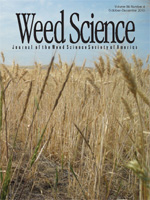The objective of this study was to define further the environmental requirements for safe sites for germination of diffuse knapweed achenes (seeds). Germination temperature profiles were developed for diffuse knapweed seeds collected from sites in the Great Basin and Colorado. Each profile consisted of seeds germinated at 55 constant or alternating temperatures from 0 through 40 C. The resulting germination was used to develop quadratic response surfaces with regression analysis. Some germination occurred from 71 to 96% of the temperature regimes, depending on the accession being tested. Maximum observed germination ranged from 85 to 98%. Optimum germination, defined as the maximum observed minus one half the confidence interval at the 0.01 level of probability, occurred at a wide range of temperatures from cold periods of 0 through 20 C, alternating with warm periods of 10 through 35 C. The temperature regimes that most frequently supported optimum germination were 5/25 C (5 C for 16 h and 25 C for 8 h in each 24-h period) and 10/25 C. Germination of diffuse knapweed seeds was generally higher at alternating than constant temperatures.
Nomenclature: Diffuse knapweed, Centaurea diffusa Lam. CENDI.





